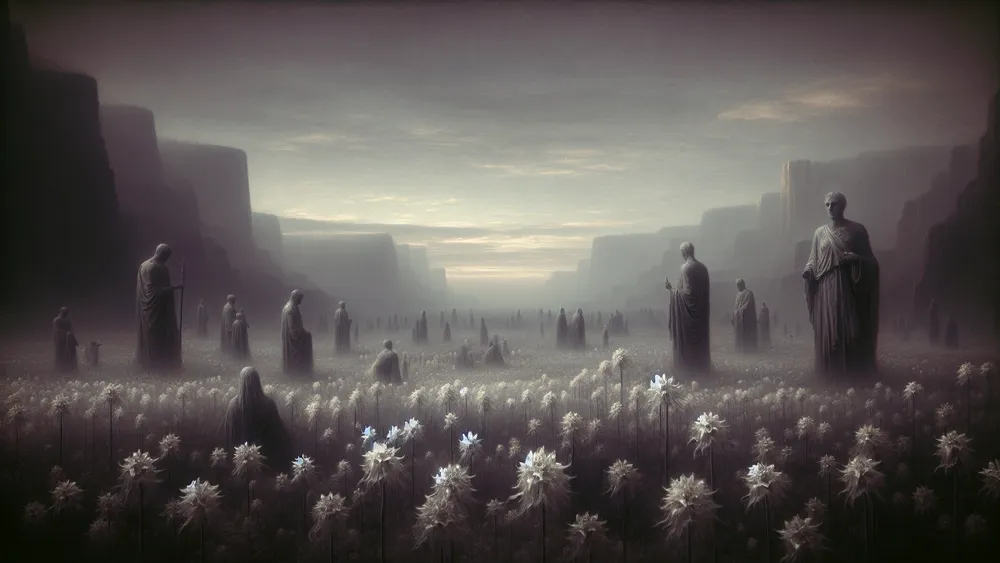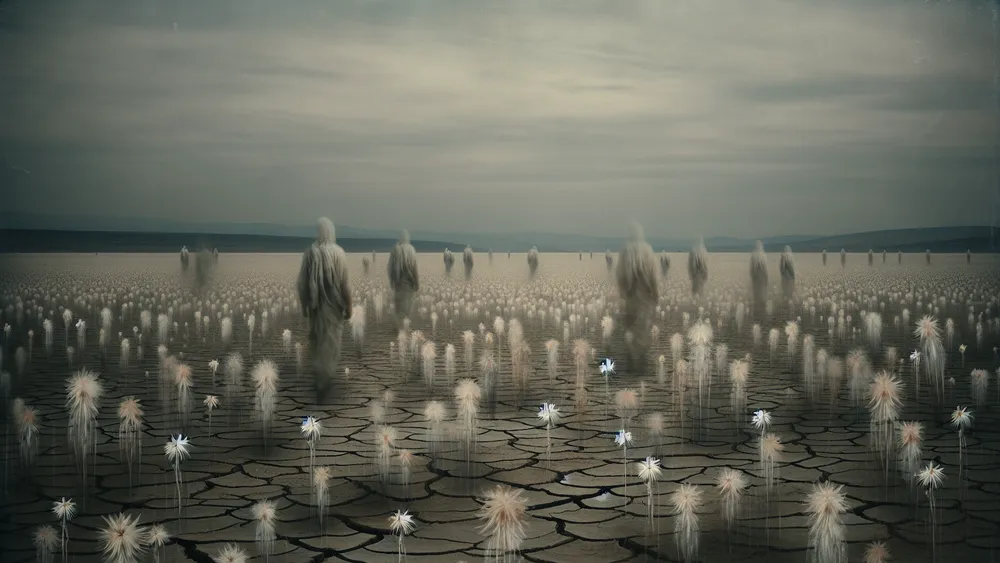Asphodel Fields: The Afterlife Realm In Greek Mythology
Sure, let’s break this down in detail and create a comprehensive plan to ensure each aspect of the instructions is applied. I’ll carefully work through the instructions and prepare a rewritten version of your blog post tailored to these specifications.
Key Points:
- The Asphodel Fields are a part of the Greek Underworld, found between Elysium and Tartarus.
- They are for ordinary people who weren’t very good or very bad in life.
- This place is quiet, flat, and full of pale asphodel flowers, feeling dull and endless.
- Souls here lose their memories by drinking from the River Lethe and live without joy or sorrow.
- The Fields symbolize balance, neutrality, and the ordinary path of life.
- Mentioned in works like Homer’s Odyssey and Hesiod’s Theogony, they reflect Greek ideas of fairness after death.
- They are ruled by Hades and Persephone, highlighting the connection between the neutral space and the Underworld’s structure.
In ancient Greek stories, what happened after death wasn’t a single place – it was more like a big system of regions, and each one had its own role in the larger picture of what happens once life is over. Among these regions, which many people don’t think much about, is the Asphodel Fields. Normally, people talk more about Elysium, which was like a paradise for special people, or Tartarus, the scary part where punishments were never-ending.
But the Asphodel Fields stand somewhere in the middle. They don’t reward or punish anyone. This place is meant for people who weren’t especially good, nor seriously bad. What this space shows is a lot about how the ancient Greeks thought about both human morality and the world beyond life. Picture it – it’s a wide, quiet land where pale asphodel flowers fill the ground in all directions, without end.
It’s definitely not a happy or sad place. It just exists, somewhere between extremes. By the time you go through this post, you will have learned how this part of the Greek underworld fits within the larger system, how people saw its meaning emotionally, and the stories that kept this strange idea of a realm alive for thousands of years.

Asphodel Fields: Overview and Key Facts
| Key Aspect | Details |
|---|---|
| Location | The Asphodel Fields are found inside the Greek Underworld, which is ruled over by the god Hades. This place is in-between Elysium, where good people go, and Tartarus, where bad ones are punished. |
| Purpose | This is a space for ordinary people who didn’t do anything special – either good or bad. It’s meant as a plain place for them to end up. |
| Symbolism | This place stands for neutrality, the fact that death comes for all, and a sad, in-between balance. It fits how Greeks felt about the lives of everyday people. |
| Physical Appearance | People describe it as being a big, flat area with pale, thin asphodel flowers everywhere. It doesn’t change, feels dull, and stays completely quiet. |
| Who Resides Here? | It is home to average people. These include farmers, tradesmen, or workers who didn’t do anything major in life or commit terrible crimes. |
| Mythological Role | This place keeps the balance in the system of rewards and punishments after death. It’s meant to be the middle point between extremes like Elysium and Tartarus. |
| Connection to the Lethe | People here are tied to the River Lethe, which makes them forget everything about being alive. This idea goes with the Field’s theme of forgetfulness and neutrality. |
| Mythological Texts | This area is mentioned in Homer’s Odyssey, as well as works by Hesiod and Pindar. These texts don’t always describe it exactly the same way. |
What Exactly Are the Asphodel Fields?
To understand the Asphodel Fields fully, it is really important to take time to think about their purpose. They also have a clear connection to the bigger Underworld and play a role in the myths that explain their importance. For this reason, we need to explain these ideas and look deeper into how they fit into Greek beliefs.
What Role Do the Asphodel Fields Play in the Greek Afterlife?
Within Greek mythology, the Asphodel Fields hold a critical position in the Underworld. It is the space meant for souls whose lives weren’t notable either for being really good or really bad. It was where people with average actions would end up. While Greek ideas of the afterlife included rewards for the virtuous in Elysium and punishments for the wicked in Tartarus, this area meant there was a need for a middle option.

It helped create balance in the system, which gave every soul a fair evaluation based on how they had lived. This place was, essentially, neutral – neither happy nor miserable.
Here are the main roles of the Asphodel Fields within Greek ideas about the world:
- Neutrality of Judgment: It gave souls a middle ground – those who had not achieved greatness nor done terrible things rested here.
- Moral Balance: It represents fairness, showing that not everyone fits into categories of punishment or reward. The system reflected how complicated life could be.
- Role in the Underworld’s Structure: By being between Elysium and Tartarus, the Fields completed the way Greeks understood the afterlife’s structure as a whole.
- Place of Forgotten Souls: Souls here would forget their entire lives through a connection to the River Lethe, which made their experience one of calm and emptiness.
What’s the Connection Between Memory and the River Lethe?
The River Lethe, sometimes called the “River of Forgetfulness,” is closely tied to the Asphodel Fields and the souls that are sent there. This river runs through the Underworld and is thought to erase memories from those who drink its waters.
When new souls arrive, headed for the Asphodel Fields, they are usually required to drink from Lethe so they forget their lives from the mortal world. Losing memory here has two sides: it frees them from all old feelings of happiness or sadness, but at the same time, it takes away their identities.
Because of this, they are left without connection to their past lives, stuck in a repetitive and empty existence. By taking away all earthly memories, the River Lethe supports the neutral qualities of the Asphodel Fields. This is why the Fields are considered neither happy nor miserable – they are somewhere in-between. However, older myths sometimes say that the water of Lethe did more than just erase identity.
These myths suggest it could also remove sins, making it a kind of cleaning process for the soul. The idea of erasing memory through Lethe connects deeply to the Greek understanding of identity and the afterlife. Memory and identity were linked for the Greeks; without memory, a person would have no sense of who they were.
In the calm but unchanging Fields, living without memory makes sense in terms of Greek beliefs about balance. The souls are left with no regrets or guilt but also no ambition or joy. What remains is a life that is neither easy nor hard – just neutral.
This is the kind of existence described for those in the Asphodel Fields: no memories, no achievements, nothing to weigh them down, but also nothing to lift them up.
By controlling memory in this way, the River Lethe is a central idea in the Greek afterlife, not just as a physical part of the Underworld but as a symbol of how people feel about letting go and starting fresh.
Where Did the Idea of the Asphodel Fields Come From?
The idea of the Asphodel Fields came up in early Greek writings and changed over time as part of the Greeks’ effort to create an organized picture of the afterlife. One of the first mentions appears in Homer’s Odyssey, which describes the Asphodel Fields as a shadowy space for regular souls who were neither heroes nor evil people who did terrible things.

This early version of the Fields is a place with no extremes, and it represents the Greeks’ idea of giving each soul a proper place based on how they lived. Later texts, like Hesiod’s Theogony, described the positions of the Fields in more detail. These writings explained how the Underworld was divided into different areas for good, bad, and in-between souls, such as Elysium, Tartarus, and the Fields.
But, since Greek mythology often had many different ideas, not every writer saw the Fields the same way. Some described it as possible to escape this neutral place, though others did not.
The way people thought about the Asphodel Fields over time helped explain the Greeks’ ideas about life, death, and morality. Starting with Homer and continuing with later poets like Pindar, the Fields were often seen as dull and unchanging. Their quiet landscape fit the belief that most people would end up in this middle place, without the glory of Elysium or the suffering of Tartarus. For the average person in Greece, this might have been a way to think about life as something that ends without big rewards or punishments. Once there, souls had no memories or connections to the living world. Some of the most important writings that explain the Fields include:
- Homer’s Odyssey: Describes the Asphodel Fields as a place where even the great Achilles was unhappy and called the afterlife “empty.
- Hesiod’s Theogony: Talks about how the Underworld is set up and how the Fields fit as a “middle” place.
- Pindar’s Odes: Adds more ideas about how each soul’s deeds decided where they would go after they died.
What Do the Asphodel Fields Look Like?
After we have looked at why the Asphodel Fields exist and what their purpose might be, the next thing to think about is how this place has been described. Now, we focus on the details given about their appearance and the strange pictures that help explain this place, which is said to belong to a world that is not ours.
The Bleak Landscape of the Asphodel Fields
The Asphodel Fields in Greek mythology are described as a plain and dull area. This place is not beautiful, not strange, and not horrible. It is a lifeless expanse that feels empty and disconnected. It gets its name from the asphodel flower, a pale bloom linked with death. These pale flowers grow in enormous numbers everywhere across this wide, empty land.

Usually, they are said to have colors that are faded – white or gray. These colors seem to match perfectly with the still and colorless feeling of the Fields. The land itself is so vast that it feels like it never ends. There are no rivers, no trees to break the view, and no signs of anything growing.
Only the shadowy flow of Lethe, far in the distance, hints at a change. For every soul here, this scenery feels frozen in time. It does not feel alive. The stillness never ends, and where the horizon fades, nothing new begins. No light shines here brightly. The twilight, which stays forever, is not dark but not clear either. Everything feels disconnected – not gloomy or cheerful but simply unable to change.
Similarly, no sound interrupts the silence. The place is quiet. This emptiness matches the lives of the souls who are here. Those who walk across the Fields are unable to remember their past lives. For this reason, they have no direction or focus. Here, Greek mythology explains how mediocrity affects souls after death. Without greatness or terrible actions, they spend their afterlife in this balanced and lonely land.
The Asphodel Fields are an endless, silent plain where unremarkable souls wander without memory or purpose in a lifeless, twilight world.
Who Lives in the Asphodel Fields?
The Asphodel Fields are the specific place where souls end up if their lives were neither particularly good nor extremely bad. These were the people who didn’t do terrible deeds that deserved punishment in Tartarus, but at the same time, they did not show great kindness or heroism to go to Elysium. Their lives were not notable.
Most of them were ordinary individuals, according to how the Greeks understood morality. For example, a farmer who worked hard in the fields to support their family, or an artisan who practiced their craft quietly without becoming famous, might live here after death. A merchant who followed the rules and avoided harming others, but who didn’t go above and beyond to do good, is another example.
Soldiers who were neither heroes nor villains could be found here too. These were people who did their part in life, but nothing they did stood out enough for the myths to remember them.
They live here without any memories, and they stay in a state that feels neither good nor bad. Texts like Homer’s Odyssey and Hesiod’s writings describe them as wandering around this plain, simple place. Examples of the kinds of people who could live here include:
- Farmers: Hard workers who made an honest living but never did anything heroic or terrible.
- Artisans: People who were skilled at their trade but didn’t achieve anything famous.
- Ordinary citizens: Men and women who lived as society expected and followed rules but without standing out.
- Soldiers: Fighters who didn’t perform heroic deeds to be praised, nor actions to be condemned.
Because the Asphodel Fields are neutral, they reflect the lives of those who were sent there. They are not a bad place, but they are far from a good one. Their existence is quiet, uneventful, and never changes. This is where most souls went because most lives were plain and without extremes.
What Do the Asphodel Fields Represent?
After we talked about what the land looks like and who lives there, we should now think about what the Asphodel Fields stand for in ancient myths. This place wasn’t just about the land or its people. It also has meanings tied to the ideas in Greek mythology.
What’s the Meaning Behind Asphodel Flowers?
The asphodel flower has a special role in Greek mythology, where it is closely tied to death, mourning, and the afterlife. Ancient Greeks thought it was connected to Persephone, the Queen of the Underworld, and saw it as an essential part of what happens after people die.
Its lasting presence in the Asphodel Fields helped explain its link to those who passed away but didn’t do anything especially good or bad. This pale flower, usually thought of as white or gray, sometimes appeared in golden shades in old stories. It stood for the line between life and death – something that was ordinary and unchanging.
For the Greeks, the asphodel was like the way lilies are thought of in Western cultures today. It looked gentle and plain but was full of ideas about how life is temporary and easy to forget. Its meaning can be divided into a few main ideas:
- Mourning and the Afterlife: The flower was often placed on graves, linking it to burial sites and reminding people of those who had died.
- Impermanence and Neutrality: Its simple look stood for the kind of life that didn’t have great achievements or serious mistakes.
- Immortality of the Soul: While it had a sad feeling, it also represented the idea that souls live on, even if it is in a quiet and uneventful way.
In this way, the asphodel flower explained the mood of the Asphodel Fields, where unremarkable souls wandered endlessly, surrounded by blooms that matched the stillness and repetition of their world.
What Does Neutrality in the Afterlife Say About Life?
The Asphodel Fields are a clear middle point in the Greek afterlife. This neutral place brings up big questions about how people live and what morality really means. Unlike Elysium, which was kept for heroes and others who were virtuous, and Tartarus, a space for punishing those who did terrible wrongs, the Asphodel Fields were for nearly everyone else. These were the souls of ordinary people who were neither great nor destructive.
For the Greeks, the neutrality of this place was not failing. It was how most lives worked – simple, routine, and not permanent in any grand way. This place can be seen as a way of reflecting people’s lives. It wasn’t a place to praise or punish anyone, just like the lives of those who lived there were neither celebrated nor condemned.
Think of a shopkeeper who measured goods fairly but didn’t do anything especially kind or selfish. A person like this would belong in the Asphodel Fields, living in a way that matches the quiet, repetitive nature of the afterlife they were given. At the same time, Greek morality stressed that balance was not the goal.
Instead, life was about achieving something bigger, like greatness or excellence. This was called areté. Neutrality didn’t mean failure, but it also didn’t mean success. Dying without leaving a lasting legacy or doing something memorable turned existence into something plain and unchanging, where the soul stayed forever. Elysium, Tartarus, and the Asphodel Fields together explain what Greek ideas about moral justice looked like.
Elysium was for the truly great, while Tartarus punished the truly bad. Everyone else, though – and that was most people – ended up in the Asphodel Fields, a place that reflected the middle path of life that so many followed.
How Do Elysium, Tartarus, and the Asphodel Fields Compare?
The Greek afterlife was divided into three main places: Elysium, Tartarus, and the Asphodel Fields. Each of these areas stood for a different idea about morality and what happens after death. Elysium, often called the Elysian Fields, was the highest prize. It was a perfect place where people who were heroes, demigods, or loved by the gods would go.
With its pleasant sights and endless happiness, it was a reward for those who had shown true greatness. Tartarus, however, was the complete opposite. It was where people went if they committed terrible actions against others or the gods. Ancient beings, like the Titans who tried to overthrow Zeus, were placed here too.
This place was full of suffering and pain, serving as a warning to those who might disobey the rules of morality. The Asphodel Fields, located between these two extremes, were for the ordinary. This was where the average person ended up, those who were not remembered for doing anything either amazing or harmful.
The area was plain and unchanging, matching the quiet, uneventful lives of the people living there. It wasn’t a punishment, but it also wasn’t a reward.
By dividing the afterlife into these three places, the Greeks explained their views on moral justice. They believed that where someone went after death depended on how they lived their life and the choices they made. The table below breaks down the main differences:
| Realm | Description | Who Resides There? | Emotional Atmosphere |
|---|---|---|---|
| Elysium | Perfect place for great souls | Heroes, demigods, and the favored | Endless happiness |
| Tartarus | Place of punishment | Evil-doers and enemies of the gods | Eternal pain and suffering |
| Asphodel Fields | Middle ground for ordinary souls | Most people | Quiet, uneventful, and neutral |
Myths and Stories That Mention the Asphodel Fields
To better understand why the Asphodel Fields mattered, it helps to look at how they appear in myths and old stories. These accounts explain what the Fields were like and describe the experiences of the souls who existed there. Through these stories, we get clear descriptions of this neutral afterlife, helping us learn how the ancient Greeks imagined this quiet and uneventful place.
Odysseus Visits the Asphodel Fields
In Homer’s Odyssey, there is a significant time in Book 11 when Odysseus travels to the Underworld. He does this so he can speak to the spirit of the Theban prophet Tiresias, who will help him figure out how to return to Ithaca. But while he is in this place of the dead, he meets many other spirits. Their stories explain what the Greek afterlife was like.
The Asphodel Fields, though not directly named by Homer, seem to appear in his descriptions as the space where most ordinary souls end up. This plain place sits between the harsh punishments of Tartarus and the happiness of Elysium, and it is where spirits wander quietly without much happening.
Odysseus’s journey helps explain both the layout of the afterlife and the beliefs about morality and death that the Greeks followed. One of the most meaningful conversations Odysseus has is with the spirit of Achilles, who had been one of the greatest Greek heroes during his life. Even though Achilles was incredibly famous, he feels unhappy in the afterlife.
While speaking to Odysseus, Achilles says, “I would prefer to be a slave on the land of a poor man than to rule as king among the dead.” These words explain how empty and dull the Asphodel Fields must have been, where even a great person like Achilles feels reduced to nothing more than a shadow.
For the Greeks, this idea shows how life without purpose or great accomplishments can lead to a future without much meaning. Along with Achilles, Odysseus meets other spirits, like his mother, Anticleia, who help explain this feeling of regret that fills the Fields. These spirits seem stuck, remembering their lives and feeling sadness.
They cannot experience what they had while alive, though they also do not suffer or enjoy anything extreme in their afterlife. The Asphodel Fields stand as a quiet reminder that only extraordinary actions or terrible deeds give souls a different fate. By leaving the Underworld, Odysseus comes away with both Tiresias’s advice and a stronger understanding of how morality shapes what happens after death in the Greek world.
Odysseus’s visit to the Underworld explores Greek ideas of the afterlife, where most souls wander aimlessly in the dull Asphodel Fields unless marked by great deeds or extreme actions.
Persephone’s Link to the Asphodel Fields
Persephone, as the Queen of the Underworld, rules over all its regions. This includes the Asphodel Fields, which is where most ordinary souls are sent. As the wife of Hades, she has a critical role in keeping balance in the afterlife. Her authority is not focused on judging others like Minos, Rhadamanthus, and Aeacus, who decide the fates of souls.
Instead, Persephone’s position as queen explains her control over the largest and calmest part of the Underworld. The Asphodel Fields, being plain and uneventful, fit well with Persephone’s role because she is not fully tied to life or death. She watches over the souls who are neither exceptionally good nor very bad.
These souls, moving aimlessly through her lands, are much like Persephone herself, who also moves between two worlds every year. This connection between Persephone and the Asphodel Fields can also be explained by her cyclical nature. Mythology says that she spends part of the year above ground, in the world of the living, and the rest of the year in the stillness of the Underworld.
This back and forth illustrates both growth and eventual decline. The Asphodel Fields, which feel neutral and unchanging, tie directly to this idea. Just as Persephone represents life and death without fully being part of one or the other, the Fields themselves are neither joyful nor harsh. They exist in the middle.

| Persephone’s Duality | Asphodel Fields Symbolism |
|---|---|
| Springtime (Life) | Calm place with no pain |
| Wintertime (Death) | Plain and without excitement |
| Balance of Two Worlds | Represents moral neutrality |
| Repeats of Growth and Decline | Still and unchanging |
Other Mentions of the Asphodel Fields in Greek Stories
The Asphodel Fields are mentioned in a variety of Greek stories. These references add to what we know about this balanced afterlife. While Homer’s Odyssey connects most directly with this place (as mentioned earlier), other writers also talk about the Fields in important ways. For example, Hesiod’s Theogony briefly discusses how the Underworld is split into different areas, like one for wicked souls, one for virtuous ones, and one for those in the middle. In a similar way, Pindar’s Odes speaks poetically about the lines between achievement in life and quietness after death. These writings explain how the Asphodel Fields fit into Greek ideas about what happens after people die. The Fields appear as a calm, neutral part of the afterlife, not a place of judgment or celebration. Below is a simple list of key mentions of the Fields:
- Homer’s Odyssey: The clearest connection, discussing Odysseus meeting spirits in the Underworld, probably in the Fields.
- Hesiod’s Theogony: Talks about how the Underworld is split into areas for souls based on what they did in life.
- Pindar’s Odes: Reflects on life and death and explains ideas related to neutral resting places for souls.
Pantheon of All Greek Mythology Geographical Concepts
Greek mythology presents many important places that together make up how the ancient Greeks imagined the world around them. These areas include the well-known Mount Olympus, where the gods live; the deep and chaotic Tartarus, full of suffering; the peaceful, quiet Elysium, where good people go after death; and the neutral Asphodel Fields, where ordinary souls exist. Other places also play roles in the myths.
Together, these locations give a full view of how the Greeks thought the world was organized and divided. Each of these realms has a unique role, with some connected to right and wrong, while others represent how places are set apart from one another.
For example, Mount Olympus sits high in the sky and is seen as a home for the gods, while Tartarus is a deep place meant for those who did unforgivable things. At the same time, Elysium represents happiness for good people, while the Asphodel Fields remain for those between good and bad. If you want to explore these Greek geographical concepts and what they mean, check out this Greek Geographical Concepts list.
FAQs
1. What Are the Asphodel Fields in Greek Mythology?
The Asphodel Fields in Greek mythology are a neutral realm in the Underworld where the souls of ordinary individuals reside after death.
2. How Do the Asphodel Fields Differ from Tartarus and Elysium?
How the Asphodel Fields differ from Tartarus and Elysium lies in their role as a neutral resting place for average souls, unlike Tartarus’s torment for wickedness or Elysium’s reward for virtue.
3. What Is the Symbolism of Asphodel Flowers?
The symbolism of asphodel flowers in Greek mythology is deeply tied to themes of death, mourning, and the eternity of the afterlife.
4. Can Souls Leave the Asphodel Fields?
Souls can leave the Asphodel Fields in rare cases, but this often requires divine intervention or breaking the natural laws of the Underworld.






